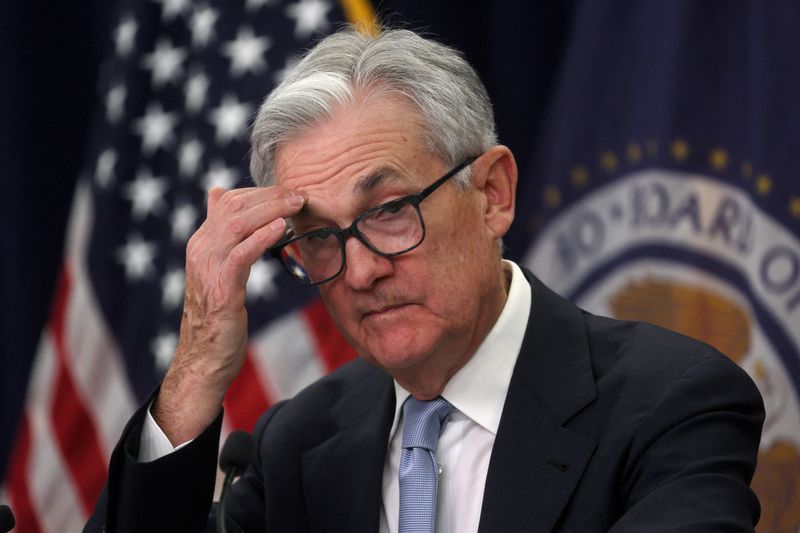By Yoruk Bahceli and Naomi Rovnick
(Reuters) -As markets bet banking turmoil will prompt the Federal Reserve to pause rate hikes before Europe, U.S. bonds and European equities are tipped to win from the recent ructions.
The Fed delivered a small 25 basis-point (bps) rate hike on Wednesday and hinted rises may end soon, with Chairman Jerome Powell admitting the central bank needs to consider how much the turmoil has tightened financial conditions.
But European peers powered ahead on Thursday. Britain and Norway hiked rates by 25 bps each, the Swiss National Bank jacked up rates by 50 bps. Norway and Switzerland signalled more increases ahead.
The Swiss move in particular highlighted that European central bankers were more sanguine about banking fears than the Fed, coming on the heels of Credit Suisse's rescue by UBS that rocked financial markets.
The SNB pushed on, saying the takeover "put a halt to the crisis". The European Central Bank hiked rates by 50 bps a week ago.
"The Fed's dovishness shows the regional bank issue is still ongoing and will have a far bigger impact on credit conditions there than in the UK or Europe," said Investec's head of UK equity strategy Roger Lee.
Indeed, many investors take the view that Credit Suisse's woes are idiosyncratic and European banks are better regulated. They also expect smaller lenders in the United States, at the heart of the banking turmoil, will have a bigger impact on the U.S. economy, raising recession risks in the world's largest economy.
So while traders price in a swift end to Fed hikes, seeing just under a 50% chance of a 25 bps move in May, followed by rate cuts, further tightening is anticipated in Europe.
ECB rates are seen peaking near 3.5% this year, from 3% before the ECB's policy meeting last week.
The Bank of England, battling double digit inflation, is expected to raise rates by another 25 bps by June.
The outlook is highly uncertain. BoE chief Andrew Bailey said he did not know if Thursday's hike was the last one, ECB boss Christine Lagarde has said market turmoil may do some of the ECB's tightening for it if it dampens demand and inflation.
WINNERS
Bets that U.S. rate cuts will come well before an easing in Europe left investors upbeat on U.S. government bonds.
Two-year Treasury yields have slid 92 bps this month, versus 60 bps in Germany. Yields move inversely with prices.
"The main takeaway is that it's likely the end is near in terms of the Fed hiking, we're seeing more priced in for rate cuts by the end of this year," said Gerard Fitzpatrick, head of fixed income at Russell Investments. "That will be positive for the duration for the (U.S.) bond market"
Fitzpatrick said he was positioned for a steepening of the U.S. yield curve, expecting shorter-dated yields to fall further, while European bonds could come under pressure given sticky inflation.
With banking sector problems expected to be a bigger drag on the U.S. economy, some investors saw U.S. stocks as overvalued.
ClearBridge strategist Jeffrey Schluze said, European banking regulation since the global financial crisis has been more stringent than in the United States, making the outlook for European lenders relatively strong.
Investors are the most overweight European stocks relative to U.S. peers since October 2017, according to a BofA Fund Manager survey that was conducted between the collapse of Silicon Valley Bank and the Credit Suisse turmoil.
While banking stocks have been battered globally, the S&P 500 is up 0.5% this month, while Europe's STOXX 600 index down 3.2%.
"The valuation of the S&P 500 relative to where (Treasury) yields are at the moment is high if there's going to be a recession. Europe is trading about in line with historical averages and the UK looks cheap," Investec's Lee said.
CHANGE IN TONE
Before the banking turmoil, markets were driven by one-way moves as high inflation pressured U.S. and European markets.
The U.S. dollar captures the change in tone. Jumping 2.8% against six major peers in February, the dollar index was heading for its longest daily losing streak in 2/12 years on Thursday and has lost 2.7% in March.
Now, currencies of emerging economies where borrowers take out loans in dollars and repay them with domestic currency revenues, are bouncing. The South African rand is up 1.5% against the dollar this week. Mexico's peso has soared 18% after two weeks of heavy losses
"Before it was about how the U.S. is being more aggressive and the dollar was going up," said Divyang Shah, strategist at Refinitiv's IFR Markets. "What this means for markets is that there will be more cross-market volatility as people play divergence themes again."
